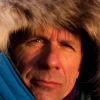James Balog

James Balog
James Balogis an American photographer whose work explores the relationship between humans and nature. Since the early 1980s Balog has photographed such subjects as endangered animals, North America’s old-growth forests, and polar ice. His work aims to combine insights from art and science to produce innovative, dynamic and sometimes shocking interpretations of our changing world...
NationalityAmerican
ProfessionPhotographer
Date of Birth15 July 1952
CountryUnited States of America
The scientist-community guy may get a $500,000 grant, and if his equipment works or doesn't work, he still gets a gold star for doing the science experiment. For me, there is no merit in anything for doing an experiment; I have to go home with pictures.
It's important to recognise that humans are not the measure of all things... The Earth is the measure of all things.
Science by itself is about numbers, and it's about measuring things. It's very important but it's very dry.
Climate change is real. Climate change is being substantially increased by humans and the carbon we put into the atmosphere. And it appears to be speeding up. If science has made any mistakes, science has been underestimating it.
You know, I've read Joseph Conrad's 'Heart of Darkness' about fifteen times.
Hindsight can be merciless. People of any given era often look back in time and wonder how their predecessors could have been so dimwitted.
This air we breathe is precious, and the glaciers helped me understand that and stay focused on that.
I grew up in suburban New Jersey in a transitional area that was surrounded by farmland that wasn't being cultivated.
Once upon a time, I was a climate-change skeptic.
You know, we humans are programmed to think that big changes on the Earth happened a long time ago, or will happen a long time in the future. What we don't realize is that they actually can happen right now. Right here, right now, while we're alive, in our own hours and days and months and years.
We are now beyond nature's normal variation in terms of how the atmosphere is composed. Nature did something for a million years. It actually goes back a lot further than that, but the ice core records show a million years. So, nature has this normal oscillation within this zone, and all of a sudden, we're forty percent outside that zone.
We still carry this old caveman-imprint idea that we're small, nature's big, and it's everything we can manage to hang on and survive. When big geophysical events happen - a huge earthquake, tsunami, or volcanic eruption - we're reminded of that.
We as a culture are forgetting that we are actually natural organisms and that we have this very, very deep connection and contact with nature. You can’t divorce civilization from nature - we totally depend on it.
I've always believed that photography is a way to shape human perception.